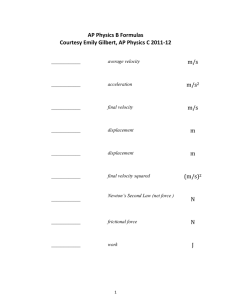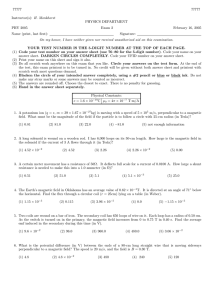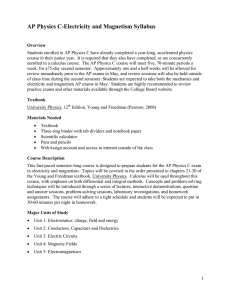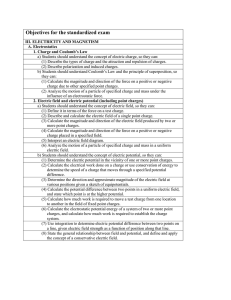Practice Exam 1
advertisement
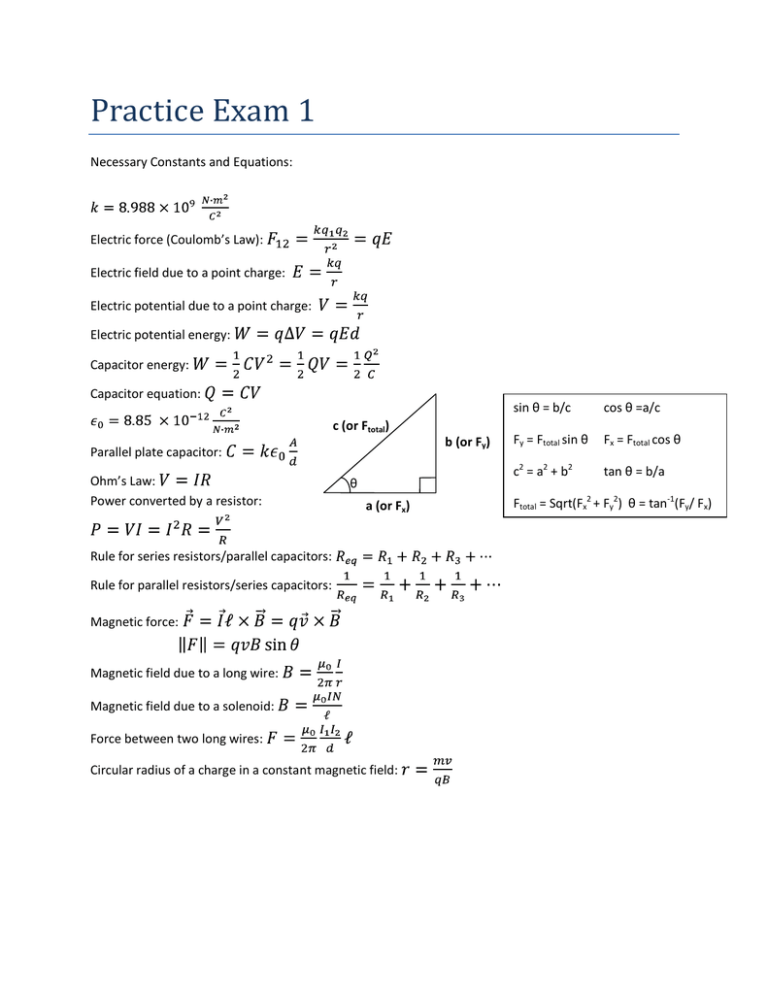
Practice Exam 1 Necessary Constants and Equations: Electric force (Coulomb’s Law): Electric field due to a point charge: Electric potential due to a point charge: Electric potential energy: Capacitor energy: Capacitor equation: c (or Ftotal) b (or Fy) Parallel plate capacitor: Ohm’s Law: Power converted by a resistor: θ a (or Fx) Rule for series resistors/parallel capacitors: Rule for parallel resistors/series capacitors: Magnetic force: Magnetic field due to a long wire: Magnetic field due to a solenoid: Force between two long wires: Circular radius of a charge in a constant magnetic field: sin θ = b/c cos θ =a/c Fy = Ftotal sin θ Fx = Ftotal cos θ c2 = a2 + b2 tan θ = b/a Ftotal = Sqrt(Fx2 + Fy2) θ = tan-1(Fy/ Fx) 1) (One point) An aluminum sphere is charged by bringing a negatively charged ball close to it, while the aluminum sphere is connected to the ground. This is an example of: A) Charging by induction B) Charging by conduction C) Charging by friction D) None of the above 2) (One point) Most atoms in everyday life are A) Positively charged B) Electrically neutral C) Negatively charged D) None of the above 3) (Two points) Two negative point charges repel each other with a force of 0.1 mN. What will be the new force if one of the charges is doubled? A) 0.025 mN B) 0.05 mN C) 0.1 mN D) 0.2 mN E) 0.4 mN 4) (Two points) Two equal positive point charges are separated by a horizontal distance of 1m. At what point along the line connecting the two charges is the electric field zero? A) 1 meter leftward of the left-hand charge B) 0.5 meters leftward of the left-hand charge C) 0.25 meters to the right of the left-hand charge D) 0.5 meters to the right of the left-hand charge E) 0.25 meters to the left of the right-hand charge 5) (One point) What are the correct units for capacitance? A) Newtons per coulomb (N/C) B) Joules per coulomb (J/C) C) Coulombs per volt (C/V) D) Coulombs per kilogram (C/kg) E) Newton meters-squared per coulomb-squared (N m^2 / C^2) 6) (Two points) Which of the following statements about the electric potential due to a point charge are true: A) Potential is directly proportional to the charge B) Potential is directly proportional to the mass C) Potential is inversely proportional to the square of the distance D) Both A and B E) Both A and C 7) (Three points) A positive charge of +0.5mC has an electric potential energy of +90000J (90kJ) when placed 5cm from a second charge Q. What is the magnitude and sign of the charge Q? A) +20mC B) -20mC C) +10mC D) -5mC E) +1mC 8) (Two points) Calculate the force between a -3.0μC point charge and a +5.0μC point charge placed 10 cm apart. A) 2.6MN B) 13.5N C) 1.35N D) 13.5mN E) None of the above 9) (One point) A capacitor experiences a potential difference of 12V when holding 5.0μC of charge on each plate. What is its capacitance? A) 0.42μF B) 4.2pF C) 6.0μF D) 60 F E) None of the above 10) (Two points) An air-filled (k=1) parallel plate capacitor is fully charged to hold charge Q by a voltage V. The voltage source is then disconnected, leaving the plates charged. What is the new voltage difference between the plates if a dielectric of dielectric constant k=4 is inserted between the plates? A) 4 V B) 2 V C) V D) 1/4 V E) None of the above 11) (Two points) A battery powered flashlight uses two 1.5V batteries in series to provide 3V to a 24Ω light bulb. How much charge passes through the batteries in 15 minutes? A) 112.5 C B) 1.875 C C) 0.125 C D) 56.25 C E) None of the above 12) (Two points) If two equal resistors are wired in series, then they share the same: A) Current B) Voltage Difference C) Power D) More than one of the above E) None of the above 13) (One point) Which one of the following statements about simple circuits is not correct? A) The sum of the changes in voltage around any complete loop in a circuit is zero. B) The voltage drop across a resistor is given by V = IR. C) The less resistive of two resistors in parallel will carry a greater current. D) The total capacitance of three capacitors in parallel is less than any one alone. E) The larger of two capacitors in parallel will store more charge. 14) (Two points) What are the maximum and minimum resistance that can be achieved with one 100ohm resistor and two 65-ohm resistors? A) 130 Ω max ; 65 Ω min B) 230 Ω max ; 24.5 Ω min C) 24.5 Ω max ; 1.54 Ω min D) 230 Ω max ; 0.041 Ω min E) None of the above 15) (Two points) Suppose that a heart patient has had probes implanted into her skin on either side of her heart, with a total resistance measured at 0.5 Ω. What is the maximum safe voltage she can come into contact with, to avoid a deadly 100mA current? A) 5 V B) 1 V C) 0.5 V D) 0.05 V E) None of the above 16) (Three points) What would the current through the following circuit be if a 25V potential difference is applied between A and B? 10 Ω A B 5Ω 15 Ω 500 Ω A) 1.37 A B) 1.63 A C) 1.66 A D) 48.2mA E) None of the above 17) (Three points) Suppose two wires of length 2 meters, separated by 5cm, attract each other with a force of 1mN. If one of the currents is 5A, directed upward, what is the magnitude and direction of the other current? A) 25 A upward B) 500A upward C) 5A downward D) 10A downward E) None of the above 18) (Two points) What is the magnitude and direction of the magnetic field 10cm to the right of a wire carrying a current of 10A directed into the page? A) 2 x 10-7 T downward B) 1.2 x 10-4 T leftward C) 2 x 10-5 T downward D) 2 x 10-5 T upward E) None of the above 19) (Two points) What would be the magnetic field required to make a one milligram, 5.0C charge traveling at 60 m/s rotate in a circle of radius 1 m? A) 12 µT B) 1.2µT C) 3.3nT D) 83nT E) None of the above 20) (Four points) The Large Hadron Collider has a radius of 13.5km, and will eventually collide protons (q=+1.6 x 10-19 C) with an energy of 13TeV (13 x 1012 eV), which corresponds to a momentum (mv) for each proton of 4.16 x 10-17 kg m/s. If the magnetic field that steers the protons into a circle is generated by passing a current through a superconducting solenoid 0.5m long, with 1000 turns of wire, how much current would be needed? A) 15.3A B) 7.67A C) 1.28 x 10-26 A D) 7.67kA E) None of the above Short answer questions: Please answer the question in the space below, continuing your answer on the back of the sheet if necessary. Remember to draw an accurate diagram and show as much work as possible. 1) Consider a square 0.2m on a side, with a -10µC point charge at each corner. a. Calculate the electric field vector at the midpoint of the left side of the square. b. Calculate the electric potential at the center of the square (point A), the electric potential at a point 0.1 meters to the right of the right-hand side of the square at the same height as the center (point B), and the potential difference between the two (V AB). c. If an electron (q=1.6 x 10-19 C, m=9.11x10-31) is released from the point (A or B) where it has higher electrical potential energy and moves to the point where it has lower potential energy, what will its speed be when it arrives? Does it move from A to B or from B to A? 2) Find the currents through the resistors marked A and B in the diagram below. What is the power used by resistor B? What is the current through the 5V battery? 15 Ω 10 Ω 5V A 5Ω 5Ω B 10 Ω 10 V 10V 15 Ω 5Ω 3) Consider an equilateral triangle with long wires at each corner, each carrying a current. The bottom two corners carry 5A currents directed into the page, while the top corner carries a 10A current out of the page. a. Calculate the magnetic field vector at the midpoint of the bottom side (between the two 5A currents). b. Calculate the magnitude and direction of the force on an alpha particle (q=6.4 x 10 -19C, m=6.67 x 10-27kg) subjected to the magnetic field from part a), if the particle is moving out of the page at 105 m/s. What is the acceleration of the particle under this magnetic force?

